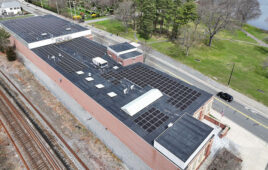By Lowell Sachs, Director of Communications, and Miriam Makhyoun, Manager of Market Intelligence, North Carolina Sustainable Energy Association
Despite low retail and avoided-cost rates, legislative threats and a regulated electricity market, North Carolina’s solar-market growth accelerated in 2013. In fact, three quarters of the state’s overall photovoltaic (PV) capacity was registered online in just the past year, but growth has been ramping up for some time.
Solar PV systems of 1 MW saw a capacity growth of 849% between 2011 and 2012, adding up to 452 MW in 2012. Systems less than 10 kW grew by 41% at the same time, representing a total of 2.4 MW in 2012. Several financial factors have driven these developments and are fostering conditions where electricity generated by utility-scale solar can soon compete with conventional electricity on a levelized cost of energy (LCOE) basis.

Grazing animals such as sheep can keep grass from overcoming ground-mounted solar arrays, as seen in this picture from North Carolina.
First, the installation cost of PV panels has substantially declined over the past few years, making solar PV-system construction more attractive and viable for a growing number of adopters. Second, the end of the commercial SunSense incentive program encouraged an increase of larger ground-mounted systems rather than smaller rooftop systems. Third, more local and regional banks are participating in the North Carolina solar market. From 2007 to 2012, direct investment in solar development reached a total of $779 million ($743 million for PV and $36 million for thermal), according to a report by RTI International and La Capra Associates.
Finally, forecast modeling, using National Renewable Energy Laboratory’s System Advisor Model, predicts that, for many electric utilities, the LCOE of solar PV systems greater than 10 kW with federal and state tax credits are or will be cost competitive with commercial retail-electricity prices in North Carolina before 2015. With the exception of PV systems of less than 5 kW and investor-owned utilities, solar PV systems with federal and state tax credits achieve grid parity with all North Carolina electric utilities before 2020. These findings assume the state tax credit will expire at the end of 2015 and the federal tax credit will drop to 10% at the end of 2016. Finally, for PV systems over 1 MW, our studies conclude that grid parity will be reached without tax credits by 2017 with all utilities. Reaching parity with the more important avoided-cost rates will take longer — but is foreseeable.
By any standard, these developments make solar a rising star within the state’s energy constellation. But it has not come without its share of struggles. Clean energy generally — and solar in particular — found itself under siege during a tumultuous legislative session this year.
Most notably, House Bill 298 and Senate Bill 365, which sought to repeal North Carolina’s Renewable Energy and Energy Efficiency Portfolio Standard (REPS) law, were only defeated after first passing out of two of the North Carolina General Assembly’s committees. In the end, legislators’ familiarity with the growth in local solar manufacturing and installation jobs, investments and tax base in their local districts, combined with public opinion polling data and solid economic and policy analysis showing a net savings to electricity customers, ultimately persuaded legislators that the REPS and the state renewable energy investment tax credit are good for North Carolina. The overwhelming majority of public comments during committee meetings on these bills were opposed to the legislation and in support of the REPS law. Many of the comments focused on the value of solar energy projects to landowners, farmers, clean-energy businesses and ratepayers. Governor Pat McCrory added to the forward march of solar’s progress when he proclaimed June as Solar Energy Month.
Much of North Carolina’s dynamic growth in solar development has been in rural areas, where jobs have been created and tax bases have grown, but there is limited education for the general public, land owners and local governments on how to facilitate solar development in a way that more fully addresses local needs. To address this challenge, the North Carolina Sustainable Energy Association and the North Carolina Solar Center initiated a project to engage the public in the creation of a template solar development and permitting ordinance intended for local governments to adapt to their particular needs. The template ordinance is expected to be available in October 2013. SPW
The North Carolina Sustainable Energy Association conducts comprehensive monitoring and measurement of the solar industry in the state and is the primary source of solar market and policy analysis for it. More information on solar in North Carolina is available online at www.energync.org.





Tell Us What You Think!